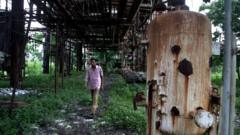In the industrial town of Pithampur, Madhya Pradesh, tensions have escalated following the arrival of 337 tonnes of toxic waste from the Bhopal gas tragedy site, one of the deadliest industrial disasters in history. Residents, particularly in Tarapur village, are alarmed at the decision to dispose of this hazardous material near their homes, fearing it could lead to severe health consequences and environmental catastrophes.
Shivnarayan Dasana, a local vegetable vendor, notes the unprecedented police presence in his village, a direct response to the protests sparked by the waste's arrival on January 3. The protests quickly escalated from peaceful gatherings to instances of stone-throwing and attempts at self-immolation, prompting authorities to register seven cases against participants.
The toxic waste, transported from the now-closed Union Carbide factory in Bhopal, includes various hazardous materials, including pesticide residue and so-called "forever chemicals." These substances are notorious for their persistence in the environment and potential long-term health hazards. Despite ongoing contamination from previous industrial activities, officials maintain that the waste disposal process is safe.
Senior government officials, including Swatantra Kumar Singh, have attempted to reassure the public by detailing the stringent incineration methods planned for the waste. Singh highlighted a high-temperature incineration process paired with a multi-layer filtration system designed to prevent toxic emissions. He ensured that the residue would be secured in a specialized landfill to avoid contaminating the surrounding soil and water.
However, local residents remain skeptical. Gayatri Tiwari, a mother of five, captured the sentiment of many when she claimed, "It's not just waste. It's poison." Citizens recalled the area's troubling history with industrial pollution, which has already tainted local groundwater and increased health issues among the population.
Environmental experts have expressed conflicting opinions regarding the incineration method. While some assert it could be safe if regulated, others, such as Shyamala Mani, advocate for alternative solutions like bioremediation, which employs living organisms to decompose toxic substances naturally, reducing harmful waste.
As protests continue, locals are raising their voices at community meetings, sharing grievances of health troubles and contaminated water, exacerbated by the town's rapid industrialization beginning in the 1980s. With concerns that present actions might simply be a superficial solution to a larger, ongoing issue, activists believe that the hazardous legacy of the Bhopal disaster remains largely unaddressed.
Prominent activist Nityanand Jayaraman has criticized the government's focus on these 337 tonnes, arguing that it overshadows the critical need for a more comprehensive approach to the unresolved pollution near the original site. He and other activists insist that Bhopal's continuing contamination should be prioritized over the disposal of waste that merely scratches the surface of the larger crisis.
With residents asserting their willingness to return to the streets if necessary, the profound impacts of the Bhopal disaster linger in Pithampur, highlighting the complex relationship between industrialization, environmental safety, and public health. As Shivnarayan Dasana succinctly put it, "It's about survival - ours and our children's."
Shivnarayan Dasana, a local vegetable vendor, notes the unprecedented police presence in his village, a direct response to the protests sparked by the waste's arrival on January 3. The protests quickly escalated from peaceful gatherings to instances of stone-throwing and attempts at self-immolation, prompting authorities to register seven cases against participants.
The toxic waste, transported from the now-closed Union Carbide factory in Bhopal, includes various hazardous materials, including pesticide residue and so-called "forever chemicals." These substances are notorious for their persistence in the environment and potential long-term health hazards. Despite ongoing contamination from previous industrial activities, officials maintain that the waste disposal process is safe.
Senior government officials, including Swatantra Kumar Singh, have attempted to reassure the public by detailing the stringent incineration methods planned for the waste. Singh highlighted a high-temperature incineration process paired with a multi-layer filtration system designed to prevent toxic emissions. He ensured that the residue would be secured in a specialized landfill to avoid contaminating the surrounding soil and water.
However, local residents remain skeptical. Gayatri Tiwari, a mother of five, captured the sentiment of many when she claimed, "It's not just waste. It's poison." Citizens recalled the area's troubling history with industrial pollution, which has already tainted local groundwater and increased health issues among the population.
Environmental experts have expressed conflicting opinions regarding the incineration method. While some assert it could be safe if regulated, others, such as Shyamala Mani, advocate for alternative solutions like bioremediation, which employs living organisms to decompose toxic substances naturally, reducing harmful waste.
As protests continue, locals are raising their voices at community meetings, sharing grievances of health troubles and contaminated water, exacerbated by the town's rapid industrialization beginning in the 1980s. With concerns that present actions might simply be a superficial solution to a larger, ongoing issue, activists believe that the hazardous legacy of the Bhopal disaster remains largely unaddressed.
Prominent activist Nityanand Jayaraman has criticized the government's focus on these 337 tonnes, arguing that it overshadows the critical need for a more comprehensive approach to the unresolved pollution near the original site. He and other activists insist that Bhopal's continuing contamination should be prioritized over the disposal of waste that merely scratches the surface of the larger crisis.
With residents asserting their willingness to return to the streets if necessary, the profound impacts of the Bhopal disaster linger in Pithampur, highlighting the complex relationship between industrialization, environmental safety, and public health. As Shivnarayan Dasana succinctly put it, "It's about survival - ours and our children's."






















